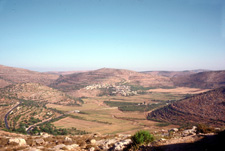|
Region
in central Palestine.
|
The
region of Samaria gets its name from the city
of Samaria, which
in Old Testament times was the capital of the
northern kingdom. When the city
of Samaria fell to the Assyrians in 722 B.C.
the region itself was called Samaria (2 Kings
17). The political boundaries of the region
shifted, but geographically it generally encompassed
the hill country between the Jezreel plain in
the north to the Aijalon valley in the south.
In
Old Testament times the tensions between this
region and the region of Judah
to the south broke into open conflict when the
kingdom split into north and south in 922 B.C.
After the Assyrians conquered Samaria in 722
B.C. many of the people were deported and foreigners
were resettled in the region. The Judeans therefore
regarded Samaritans as ethnically impure. The
Samaritans had their own center of worship at
Mount Gerizim, but Jews insisted that worship
was centered in Jerusalem.
 |
Hills in central Samaria |
In
New Testament times, Jesus encountered
some hostility from Samaritans because he worshiped
in Jerusalem (Luke 9:51-56). Nevertheless, Jesus
told a parable about a Good Samaritan (Luke 10:29-37)
and healed a Samaritan (Luke 17:11-19). He told
a Samaritan woman that right worship was not bound
to either Jerusalem or Mount Gerizim, but took
place in Spirit and truth (John 4:1-42). Mission
to Samaria began after the death of Stephen, when
Philip the evangelist
proclaimed the gospel there (Acts 8:4-8).
|